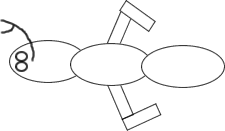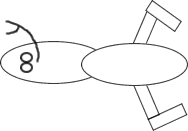Constructing a Cladogram
Objective: Students will construct a cladogram using descriptions and information about 7 imaginary animals. Students will determine which traits are derived traits, and identify synapomorphy and automorphy of characteristics.
Tips for constructing your cladogram
1. Use the times to determine the positioning of the species. Older organisms will appear first on the cladogram
2. Determine features that are shared among organisms - these are synapomorphies - Place an S on these features to help you keep track
3. Determine features that are unique to organisms - these are automorphies - Place an A on these features
4. There may be several ways to represent this cladogram, remember that cladistics and systematics is inexact, do not worry if yours looks different from others.
Fossil Species
Species 1 - Fossils of this species date back to 30,000 years ago. The organism has a single antenna that is branched (like a Y). It has two eyes positioned on top of the head a non segmented body

Species 2 - Fossils of this species date back to 8,000 years ago. This organism has branched antennae, 3 body segments, the middle segment has fleshy appendages with a bendable joint.

Species 3 - Fossils of this species date back to 25,000 years ago. The organism has a branched antenna (like a Y), body is divided into 2 segments, and eyes positioned on the top of the head. In addition, the last segment of the body has a long curley tail.

Species 4 - Fossils of this species date back to 10,000 years ago. This organism has branched antennae, 2 body segments, eyes positioned on the top of the head, fleshy appendages on the last segment have a bendable joint
 .
.
Species 5 - Fossils of this species date back to 50,000 years ago. The organism has a single antennae, two eyes positioned on top of a head and a non segmented body.

Species 6 - Fossils of this species date back to 20,000 years ago. This organism has branched antennae, 2 body segments, eyes positioned on the top of the head, and small flesh appendages on the last segment. This organism also has a ridge of spines on the last segment.

Species 7 - Fossils of this species date back to 31,000 years ago. The organism has a single branched antennae (like a Y) and a club like structure at the end of the branches of the antennae. It has two eyes positioned on top of the head and a non segmented body.

Other Resources on Cladograms
Exploring Phylogenetic Trees with Wolves - compare dogs, wolves, and coyotes and analyze a phylogenetic tree of canids
Practice with Taxonomy and Classification: reinforcement activity, focuses on kingdoms and scientific names
Bear Species and DNA - activity from Learn.Genetics explores relationships between different types of bears
Fingerprint Classification - look at fingerprints and develop a way to classify them
Taxonomy Project - students create their own kingdoms, phyla and other group classification and then design organisms
Create a Cladogram of Shapes - Use simple shapes, like triangle and square to model evolution